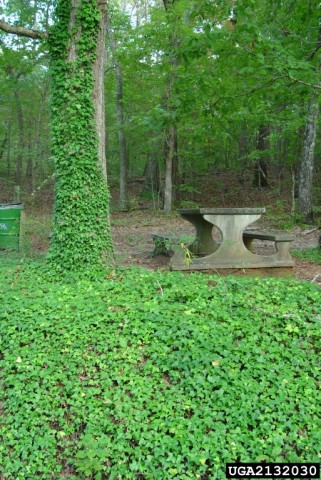
English ivy may climb up and overwhelm trees, making them vulnerable to wind damage and disease. Photo: David J. Moorhead, University of Georgia, Bugwood.org.
Autumn is an excellent time to take a look back at how your landscape and garden performed this year. Take a stroll around your yard and take measure of what worked and didn’t work and what changes you might like to make.
Landscape changes
As plants grow and mature, you may need to adjust your plantings to give them the room they need. Perhaps it’s time to transplant a shrub from an area that is getting crowded to one that could be filled in more. Perhaps the plants underneath a growing tree are getting less sunlight now, and it’s time to replace them with plants that will better tolerate shade.
Your needs may change over time too. You might like to add screening plants to block new construction next door. You might want to increase the sunlight on your patio. Consider how you use your yard and what would make it serve you better. Call us if you’d like to discuss design options.
Plants that perform poorly
Do you have any plants that didn’t grow well this year? Perhaps one was spindly, another didn’t flower or one had poor color. Did you see any with fungal disease? Now is the time to assess what could have caused the problem.
Is the plant getting too much or too little sunlight? For example, did a nearby plant grow taller, shading the problem plant?
Did it get enough water? Drought stress is becoming more common as Seattle’s summers become hotter and drier. Many trees suffered last summer because they were already stressed from the 2015 drought.
Is it getting the right nutrition? If you are signed up for our natural tree and shrub care service, we have been treating your plants over the growing season with nutrients, micronutrients and organic organisms. If not, you may need to take steps to address any deficiencies. An organic mulch, such as compost or arborist chips, will help feed your plants. You may also consider a good organic fertilizer.
Does the soil have the proper pH? Our Northwest soils tend to be more acidic. Now would be a good time to get a soil test to find out. Check out last week’s blog post to find out how to test your soil.
Plants that perform too well
Do you have a plant that is taking over an area and crowding out other plants? Consider your options. You could cut it back and wait for it to grow again. You could cut back or remove neighboring plants. Or you could remove the large plant and replace it with something else that is better suited to the location.
Here’s an example. False spirea is a lovely plant, with fernlike leaves, multicolored growth in the spring and downy white blooms later in the year. But it also spreads readily by sending out root suckers to corners far and wide. One gardener called it a “thug.”
Perhaps you planted it in an area that can accommodate a large, readily spreading shrub. If not, you need to consider what steps to take. You could remove the new sprouts each time they come up during the growing season. You could mow the entire plant to the ground occasionally to help keep it under control. You could remove it entirely and replace it with something else that is better behaved.
Invasive weeds
Now would be a good time to identify any plants that may have “volunteered” in your yard and determine if you want to keep them or remove them. Perhaps the volunteers are noxious weeds. These are non-native plants that spread rapidly and take over large areas. State and local laws require many to be controlled. Here are a few examples.
English ivy is a common ornamental, widely used in landscapes. It has been taking over many woodlands and parks in the region. It can cover everything in its reach, crowding out native wildflowers, ferns and tree seedlings. Ivy mats often host pest animals such as the Norway rat. It grows up the trunks of trees, harming the trees’ health and increasing the risk of trees being blown over in windstorms.
Giant hogweed was introduced from Asia as an ornamental. It can grow 10 to 15 high when in bloom. It resembles the native cow parsnip. Hogweed has escaped into many backyards, ravines, parks, abandoned lots, streams, woods and roadsides. It can crowd out other plants and take over natural areas, especially in moist areas. Its sap has toxins that can produce painful, burning blisters when exposed to sunlight.
Invasive knotweeds are tall, bamboo-like plants. They were introduced from Asia as ornamentals in the early 1800s in England and in the United State by 1890. They have no natural predators in the US or Europe. They readily spread by root and stem fragments. Their thickets can completely clog small waterways and crowd out native plants. This increases bank erosion and harms stream habitat for fish and wildlife.
The King County noxious weed website has information on identification and control of invasive plants.
The Garden Wise booklet shows noxious weeds and alternative, non-invasive plants for the garden.
